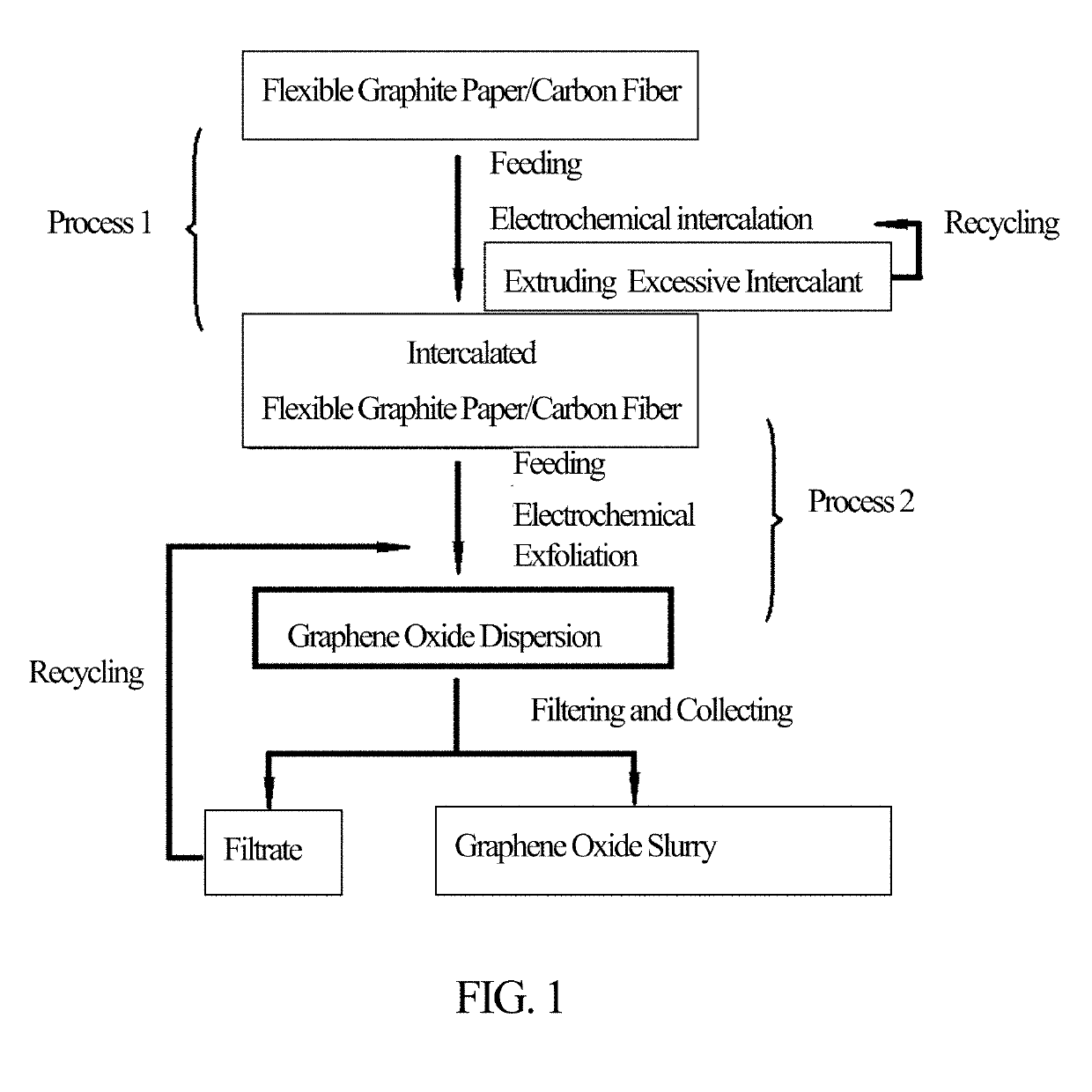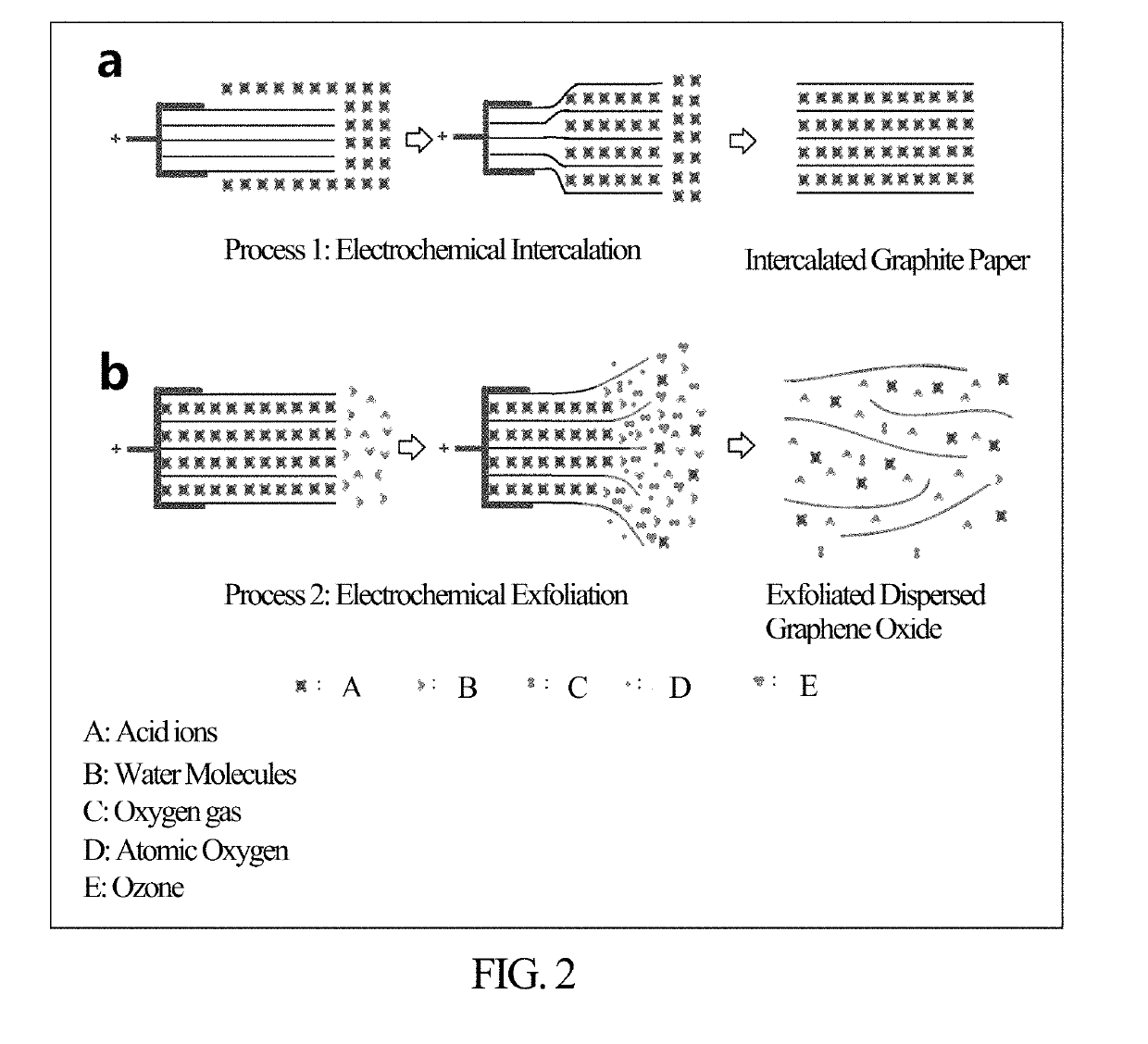Method for Continuously Preparing Graphene Oxide Nanoplatelet
a graphene oxide and nanoplatelet technology, applied in the field of graphene preparation technology, can solve the problems of limiting its use in many applications, increasing manufacturing costs, and affecting the quality of graphene oxide nanoplatelets, and achieves the effect of reducing environmental pollution and low pollution
- Summary
- Abstract
- Description
- Claims
- Application Information
AI Technical Summary
Benefits of technology
Problems solved by technology
Method used
Image
Examples
embodiment 1
[0037]The flexible graphite paper coil having a carbon content of 99.5 wt % and a volume conductivity of 500 S / cm is used as a raw material for preparing graphene oxide. Referring to FIG. 3(a) and FIG. 3(b) of the drawings, a schematic diagram of the structure of a continuous preparation apparatus used in process 1 (electrochemical intercalation) and process 2 (electrolytic oxidation exfoliation) of the present invention is illustrated. Wherein,
[0038]as shown in FIG. 3(a) of the drawings, an electrochemical intercalation device mainly comprises: a regulated DC power supply I 11, a shaft roller type feeding device I 21, an inert electrode I 31, an acid-resistant guide roller I 41, an acid-discharging roller I 51, a liquid surface of electrolytic slot I 61, and an intercalation slot 7. The specific structure is as follows: the inert electrode I 31 and the acid-resistant guide roller I 41 are disposed below the liquid surface of electrolytic slot I 61 of the intercalation slot 7. The i...
embodiment 2
[0045]The carbon fiber continuous wire having a carbon content of 99.8 wt % and a volume conductivity of 850 S / cm is used as a raw material for preparing graphene oxide. The process and device structure are similar to that of Embodiment 1 and the specific production parameters are as follows:
[0046]In the above first process, the intercalant in the intercalation slot is concentrated nitric acid having a concentration of 99 wt %, the intercalation voltage is 80 V; the maintaining time of the graphite material in the intercalation electrode region is 10 seconds, and the transmission speed of the feeding device is 30 cm / min. The length of the intercalation electrode area is 5 cm, the inert electrodes are made of graphite and positioned on the upper side and the lower side of the graphite material while leveled with the surface of the graphite material; the distance between the inert electrode and one side of the surface of the graphite material is 15 mm.
[0047]In the above second process...
embodiment 3
[0049]The flexible graphite paper coil having a carbon content of 98 wt % and a volume conductivity of 550 S / cm is used as a raw material for preparing graphene oxide. The process and device structure are similar to that of Embodiment 1 and the specific production parameters are as follows:
[0050]In the above first process, the intercalant in the intercalation slot is chlorosulfonic acid having a concentration of 100 wt %, the intercalation voltage is 60 V; the maintaining time of the graphite material in the intercalation electrode region is 30 seconds, and the transmission speed of the feeding device is 10 cm / min; the length of the intercalation electrode area is 5 cm, the inert electrodes are made of platinum and positioned on an upper side and a lower side of the graphite material while leveled with the surface of the graphite material; the distance between the inert electrode and one side of the surface of the graphite material is 5 mm.
[0051]In the above second process, the elec...
PUM
| Property | Measurement | Unit |
|---|---|---|
| volume conductivity | aaaaa | aaaaa |
| distance | aaaaa | aaaaa |
| conductivity | aaaaa | aaaaa |
Abstract
Description
Claims
Application Information
 Login to View More
Login to View More - R&D
- Intellectual Property
- Life Sciences
- Materials
- Tech Scout
- Unparalleled Data Quality
- Higher Quality Content
- 60% Fewer Hallucinations
Browse by: Latest US Patents, China's latest patents, Technical Efficacy Thesaurus, Application Domain, Technology Topic, Popular Technical Reports.
© 2025 PatSnap. All rights reserved.Legal|Privacy policy|Modern Slavery Act Transparency Statement|Sitemap|About US| Contact US: help@patsnap.com



